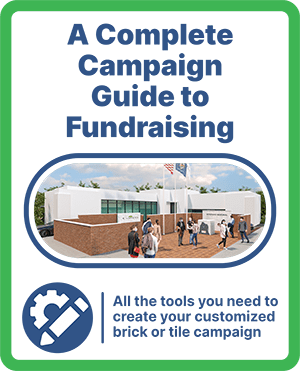 Finding the right idea for your company’s fundraising platform can be tough.
Finding the right idea for your company’s fundraising platform can be tough.
There are plenty of options available: sporting events, ice cream socials, fashion shows, shoe drives, walkathons, chili cook-offs, etc. We have all been part of these types of fundraisers — and others — at some point or another.
But are any of those ideas right for your specific business and its customers? We here at Fundraising Brick hope to provide you with a simple way to figure that out.
Before venturing out with any type of fundraiser, it’s best practice to gather all of the information that is needed and presenting your ideas to your organization or its
Board of Directors. Spend time and effort on your research with special attention to project costs, projected revenues, and timeframes for project completion. It is best to have sound figures and details to present at the first meeting.
But, before we go too far, let’s first discuss what makes for a successful fundraiser, and then we’ll get into what you can do to come up with some creative fundraising ideas to raise money for your organization.
What Makes For A Successful Fundraiser?
Secure donations
This may seem like a no-brainer, but often times business owners put in the work to hold a fundraiser without first securing the one thing that will make it successful. But how do secure donations? Simple … you ask and then you ask some more. People give because they are asked, and if you don’t ask, the answer will always be no — even if the goal is small donations. When you ask, make sure it’s apparent that you have pride in the cause for which you are committed to raising money. Undoubtedly, you feel a sense of honor to be the conduit through which people are able to support that cause, so make that obvious. It will give your efforts an important sense of genuineness.
Build loyal, happy donors
People don’t give to you because you have needs; they give to you because you meet needs or they want to support a good cause. Donors and prospects don’t want to hear about the woes of the economy or your organizational struggles — no one wants to join a sinking ship. Instead, they want to know exactly where their donations to your fundraising campaign will go, and what impact your work is having on their community and how it will resolve the issues they care about.
Establish clear goals & firm deadlines
The key to fundraising success is to clearly define your goals and establish a straightforward timeline for reaching those goals. Identify what is required to raise funds necessary for success, what resources are required to do so, and how long it will take to reach your fundraising goals.
Know your audience
Take a good, long look at the stuff you’re planning to sell and build a profile of your ideal customer. A fundraiser that appeals to one person may not necessarily appeal someone else. School fundraising, or generating money for types of nonprofit organizations, may be more successful with a specific type event, while fundraising for for-profit organization may have more luck with something else, such as a peer fundraising or a crowdfunding campaign that seeks engagement through an online donation page for a specific amount of time.
Advertise appropriately & aggressively
Utilize all avenues of advertising that will assist you in selling your fundraising product. Partner with local businesses. Run ad campaigns on social media. Create a fundraising page online that gives important details prior to your event. Engage with influential community members. Even go door to door to hand out free goodies that accompany an invite to your fundraiser.
Diversify your fundraising efforts
Fundraising is not a one-size-fits-all type of enterprise, nor is there a rule that says you can’t operate more than one type of fundraising event. The key is to create as many opportunities to collect donations as possible — raffle tickets, throw a gala, host a photo contest or movie/trivia night, partner with sports teams or local artists, etc. — so diversify the manner in which you raise money for your organization. You’ll tap previously unforeseen opportunities and capture donators that you perhaps may not have considered in the past.
The aforementioned characteristics should serve as the framework for any type of fundraiser you decide to throw for your business or organization. Follow them, and your next fundraising event will be a win-win for you and your donors.
That said, we still have not addressed the question of what type of fundraiser is right for you. The simple answer is this: There is really no right or wrong answer.
What really matters is the execution.
One of the easiest and potentially most-profitable types of fundraisers (drumroll) is a brick fundraiser. We know, surprise, surprise, right? But it’s true. And you don’t have to take our word for it.
Why Use Bricks For Your Next Fundraiser?
Engraved brick fundraising has become increasingly popular because of its profitability. The cost of securing the materials and etching a donor’s name and custom message is low compared to the amount of the donation a brick usually garners. A business can then scale this profitability in accordance with current and future funding needs.
Other benefits of using bricks as a fundraising idea include:
- Broad donor participation across race, age, education background, etc.
- Seamless implementation into an existing brick structure of a business
- Variety of applications (walkways, pavers, memorials, etc.)
- Versatile enough to be sold at array of events (book sales, talent shows, golf tournaments, yard sales, car washes, karaoke/game nights, etc.)
- Opportunities for recurring donations
- Easily utilized through online fundraising
Fundraising Brick has experience assisting in the execution of a wide variety of fundraising efforts that don’t require a lot of money upfront. This includes companies that have needed to raise a few thousand dollars for one project to some who have needed to raise funds in excess of hundreds of thousands — even millions — of dollars for larger-scale investments.
Additionally, for situations in which recurring annual donations are desired, we can coordinate the reordering of engraved brick or tile to ensure opportunities are consistently available for an institution’s donor base.
Organize Your Brick Fundraising Project
Many companies have leveraged the appeal of engraved bricks to execute successful fundraising events, but ultimately, it comes down to planning and what happens before that first brick is even engraved. Organizing a fundraiser may seem like a whirlwind; there’s so many details to address and small things to consider. But if you clean up the clutter and follow a specific roadmap, the process will operate much more smoothly.
If you’re just starting out, we’re here to help. Consider the following steps when it comes to planning out your next fundraising effort, which we recommend you start doing about two months prior.
Step 1 – Identify Goals & Other Important Fundraiser Details
- What are the fundraising goals in terms of how much money you want to raise and when you’ll need the funds?
- What are the beginning and ending dates for the project?
- What tools will be used to check your progress? (thermometers are popular)
- Does your event conflict with any other community events?
- Double-check your community calendar to confirm there are no conflicts (i.e. if so, it may be difficult to find enough volunteers for your event)
- Will you allow for online donations?
- Should consider holding your event during a specific holiday season to naturally create a theme for the big day (i.e. use Halloween to stage a haunted house)
Step 2 – Find Fundraising Sources
- Compile a list of potential donors and approach them for support
- Business and Industry (Corporate): Some businesses may agree to match funds you raise from the public sector, especially the employers of your volunteers.
- Members of your organization
- Family and friends
- Colleagues and co-workers
- Door to door solicitation
- Set your price for the bricks being sold and use sponsorship categories like business/corporate, household/family, and individual
- Typically, prices range from $50-150 for a 4X8 paver and $150-500 for an 8X8 paver
- You know your community best, so use that knowledge to determine what price will best fit your fundraising needs and generate sales for your area
Step 3 – Acquire Volunteers & Assign Committee Members
- Ask for names of those who volunteered in past fundraisers or who serve on other committees
- Form your committee: appoint a committee chairperson/president, vice president, secretary, treasurer, and any other office necessary to run your campaign
- Let volunteers/committee members indicate their interests and assign them accordingly
- Ask each recruit for a list of family and friends who may be interested in supporting your fundraising efforts through either participation or donations
Step 4 – Promote Your Fundraising Campaign
- Contact local media about your fundraiser via phone call, press release, or public service announcement
- Encourage each member of your team to spread the word to family, friends, co-workers, and neighbors
- Decorate your town with different types of advertising in high-traffic areas to ensure a good number of attendees, including:
- Bulletin boards in offices, grocery stores, malls
- Neighborhood electric poles
- Doors in nearby neighborhoods
- Mass mailings (if your budget allows)
- Church bulletins
- School or club newsletters
- Run an ad in your community newspaper
- If budget allows, print T-shirts as free giveaways that will serve as additional advertising
- Identify cost-effective ways to promote your fundraiser online; here are some examples:
- Organize a Great Advertising Committee
- Advertise your fundraiser on Squidoo
- Promote Your Event Lens Using Free Social Media
- Submit Your Event To Online Newspaper Calendar of Events
- Blog About Your Fundraising Event
- Ask Websites To Post The Link To Your Lens or Blog
- Design an Eye Catching Flyer and Distribute It!
- Design and Sell Event Merchandise With Your Advertising Flyer
- Banners and Signs Get A Lot Of Attention
- Ask Other Organizations to post your events in their newsletters or mass email
- Send out Press Releases to local newspapers and magazines
- Send PSAs to Local Radio Stations
Step 5 – Managing Your Fundraiser Money
This one should be obvious, but if you need additional assistance, you can utilize Fundraising Brick’s online ordering program to help:
- Use cash collection envelopes for each event team or individual that will collect money (this helps you keep accurate records of who collects money and in what amounts)
- Set a specific date when all money needs to be turned in
- Assign one of the volunteers to be your treasurerThe treasurer should be both experienced and comfortable with handling money (and both of you should be present when any money is counted)
- Deposit money in a timely manner (in-between deposits, keep money under lock and key)
What Is The Typical Fundraising Timeline?
The first installation should be within 3-6 months of the project’s start date. Your project might run like the timeline example below:
Month 1
Gather detailed information from your premier laser engraving brick company, Fundraising Brick LLC, for all of your fundraising needs. Price out the cost of bricks, flyer templates, donor letter templates, order form templates, brochures, fundraising guides, etc.
Month 2
Present your project to your organization or its board of directors. If you project is approved, design your layout/installation and obtain a quote for the brick installation.
Months 3-6
Set a sales goal for your fundraising project, and begin selling your bricks and set a deadline for ordering. A good timeline for selling is 2-4 months.
Month 7
Order your engraved bricks from your premier laser engraver, Fundraising Brick LLC. Receive and install your laser engraved bricks.
**This is an approximate timeline. Timeframes and campaign schedules can vary for any number of reasons. Please speak to one of our Fundraising Experts for a customized plan for your project.
Example Of A Brick Fundraiser
Bricks For Bail
Jail-N-Bail involves a mock jail set up in a school, at an event/game, a church function, or another high-traffic public area, such as a shopping center, etc.

Option #1:
Gather as many volunteers as you can to be placed in your mock up jail (between 5 & 50). Each volunteer must sell a certain number of bricks in order to be bailed out. Your organization can set the amount of bricks to be sold for the volunteer’s bail out. We recommend each volunteer be required to sell between 2 and 5 bricks for their bail. The jailbird volunteer will need to be prepared to call their friends, family, co-workers, and acquaintances to obtain their brick bail out money. After the volunteer has been bailed out, they are free to go and your organization will have achieved additional brick sales for your cause.
Option #2:
The brick bail out begins with someone calling your organization requesting the “arrest” of their boss, spouse, a politician, friend or co-worker. An off-duty police officer or volunteer “arrests” the unsuspecting participant, serving them with a brick warrant. He or she is then whisked off to “jail”. When the participants arrive at the “jail”, their bail is set by a judge. Make sure participants either have a phone or are provided with one when they arrive. The jailbirds make pledge calls for brick sales to friends, relatives, and co-workers to earn their bail.
Most incarcerations last for one to two hours.




